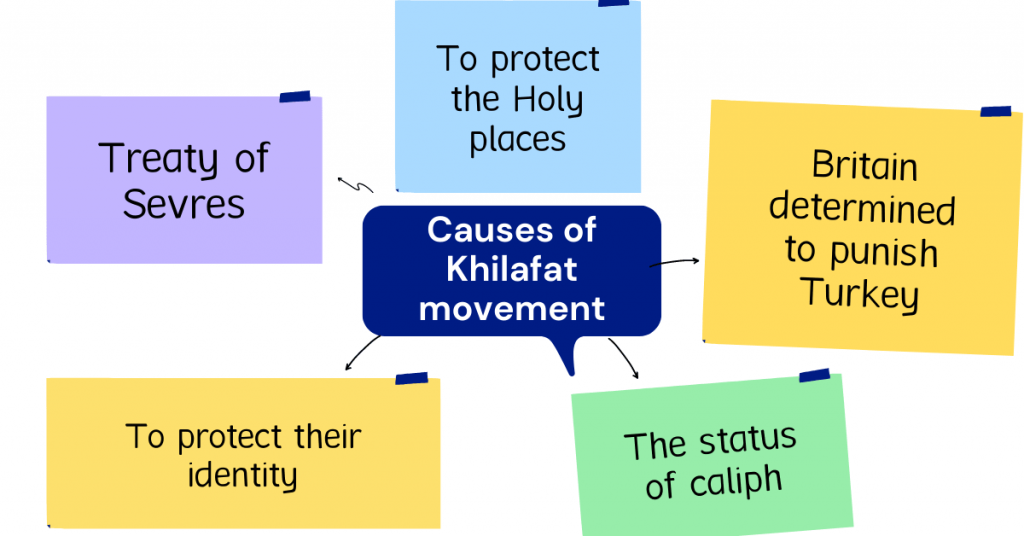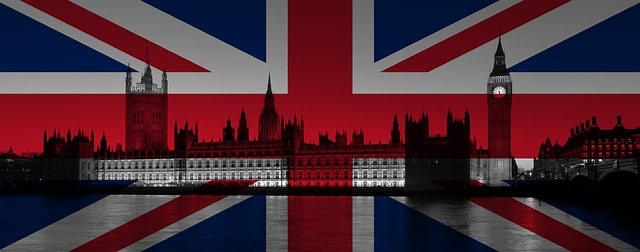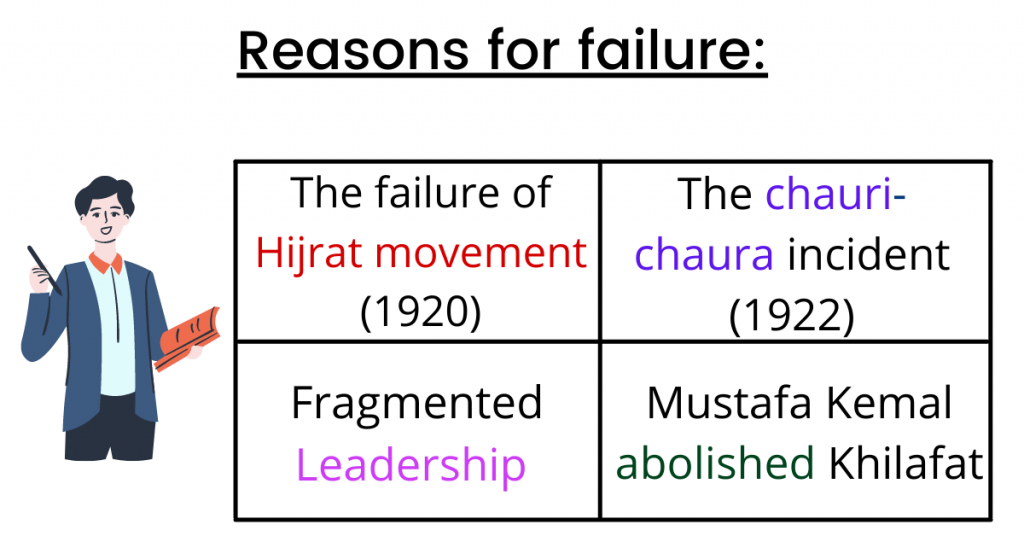The Khilafat movement arose in 1919 in India as an Islamic political protest launched by the Indian Muslims to safeguard the Ottoman caliphate and the Khalifa (caliph).
This Indian Muslim movement (1919-1924) was launched by Sunni Muslims because they regarded the caliph as their social, political and religious leader.
Note than Mehmed V| was the Ottoman sultan (caliph) from 1918 to 1920 during the Khilafat movement.
This was all about the introduction of this topic. Now, let’s discuss some important events without further introductions.
Background:
Abdul Hamid || was the Ottoman caliph from 1842 to 1918 and his aim was to safeguard the caliphate from Western attacks.
This was because the caliphate was endangered by Italian attacks (1911) and Balkan wars (1912-1913). Similarly, the defeat in the First World War also endangered the existence of the caliphate.

The leaders in British India such as Hakim Ajmal Khan, Shaukat Ali, Maulana Muhammad Ali Jauhar and Abdul Kalam Azad led a campaign to protect the caliphate because there were multiple sanctions on the caliph following the First World War.
It is to note that the sacred places for the Muslims such as Mecca and Madinah were under the caliph, which made him a significant figure for the Muslims throughout the world.
Due to these threats, the Muslims throughout the world were concerned about the future of the caliphate and the Indian Muslims launched a movement to show their support to the caliph.
Causes of Khilafat movement:
- After World War |, the treaty of Sevres intensified the fear of loss of the caliphate.
The treaty of Sevres was signed in 1920 between the Allies of World War | and the Ottoman empire. As a result, large parts of the Ottoman territory were seized are given to France, United Kingdom, Italy and Greece.
The clauses of the treaty dismembered the Ottoman empire and the Muslims were not ready to accept this loss.
- In the First World War, the Indian Muslims in the British army were reluctant to fight against their fellow Muslim brothers.
In order to convince the Muslims, the British promised them to ensure fair treatment of the Ottoman caliph after the war was over. However, when the war ended, the British were not ready to fulfil their promise.
This was because the treaty of Sevres showed that the British were determined to punish the Ottomans for fighting against them in war. As a result, the Muslims started a political campaign on a large scale to remind the British about their commitments.
- The Muslims wanted to protect their identity and status.
This was because the Muslims believed that if Britain destroyed Turkey, the Muslims would become like Jews (people without a country of their own). Accordingly, they started the movement to protect their status.
- The Holy places for the Muslims were under threat with the decline of the Ottoman empire.

As discussed above, the sacred places for the Muslims were under the control of the Khalifa (caliph) and with the defeat of the Ottoman empire, Makkah and Madinah came under the control of Britain.
The Indian Muslims launched a widespread protest to protect these places because they were very significant for the Muslims.
The non-cooperation movement:
The non-cooperation movement (led by Mohandas Gandhi) was a nationwide campaign of large but peaceful civil disobedience.
Gandhi aimed to merge his movement along with the Khilafat movement to increase the pressure on the British to leave India. However, Gandhi was supporting the Muslims as long as there was no violence.
Later, Gandhi withdrew his support when violence broke out.
The purpose of this campaign was to obtain independence with complete self-governance (Purna Swaraj) as the Indian National Congress (INC) also withdrew its support from the British reforms.
Further reading:
Population and employment | GCE O Level (2059)
Fishing Industry | GCE O Level (2059)
In Delhi, the first Khilafat conference was held (November 1919) and Gandhi also attended the conference. They decided to adopt a non-cooperation policy against the British to fulfil their religious duty.
In December 1919, the Indian National Congress and the Khilafat committee held their meeting at Amritsar. A delegation (under Maulana Muhammad Ali Jauhar) was prepared which was sent to England.
The delegation visited the Britain Prime Minister, members of parliament and the cabinet members to discuss the future of the Ottoman empire. This is known as the second khilafat conference.
The delegation paid a visit to England again in 1920 but the Llyod George (the Britain Prime Minister) was not ready to accept the demands of the Indians.

However, they managed to gain the support of some British people through their speeches but overall, the meeting resulted in no final decision.
This takes us to another very important topic that why does the Khilafat movement fail?
Reasons for failure:
- The failure of the Hijrat movement disillusioned the Muslims of the Indian subcontinent, but why?
During the 1920s, prominent Muslim leaders such as Maulana Abdul Kalam Azad and Maulana Abdul Bari called India “Dar-ul-Harb” (land of war) and motivated Muslims to migrate.
At the same time, Jamiat-ul-Ulema-i-Hind issued a Fatwa, ” Tark-e-Mawalat” and also encouraged Muslims to migrate to a safe place or fight against the British.
On the call, more than 18,000 Muslims (from Punjab, Sindh and North-West frontier province) migrated to Afghanistan because it was a Muslims country.
Initially, the Afghan government welcomed the migrants but due to the surging numbers, they denied entry to the Indian Muslims because Afganistan is a land short of resources.
The Muslims were devastated because when they returned back, they had lost their houses and jobs and they were in a pitiful condition. As a result, they lost faith in the Khilafat movement as well.
- The violence erupted due to the chauri-chaura incident shattered the Hindu-Muslim unity.
Gandhi was ready to support the Muslim cause as long as there was peace. However, the Chauri Chaura incident in the Gorakhpur district of the United Province (4 February 1922) resulted in violence.
The police opened fire on the angry peasants (fighting for the freedom of their country). In retaliation, the furious mob set the police station on fire. This resulted in the killing of 22 policemen and 3 civilians were also killed.
Due to this, Gandhi decided to withdraw his support from the Khilafat movement and the Muslims lost the vital support of the Hindus which was essential for mounting pressure on the British.
The Mophla rebellion or the Malabar rebellion also disturbed the relations between the Muslims and Hindus because the Mophla’s attacked the Hindus and the British.
The Brtish took strict measures against them when they destroyed a police station and seized the arms and ammunitions. The rebellion was crushed down by the British but it did significant damage to the Hindu-Muslim unity.
- The fragmented Khilafat leadership created a leadership vacuum which made the movement disorganized.
The prominent leaders such as Maulana Muhammad Ali Jauhar and Shaukat Ali were arrested by the British due to their constant support for the movement.

The British wanted to prevent any kind of uprising against them and therefore, they arrested the Khilafat leadership to prevent them from organizing people for a protest.
As a result, there was disorder and mismanagement and the people did not have a fixed strategy to follow to protect the caliphate in Turkey. This made the campaign gradually ineffective.
- The Khilafat delegation could not convince the British for fair treatment of Turkey and the Ottoman caliphate.
The delegation met the Brtish prime minister, members of parliament and the members of the cabinet to discuss their demands. However, the British were determined to punish Turkey for participating in the war against Britain.
The arguments and the demands made by the Khilafat committee were rejected which was a massive blow to the movement.
This was because the British were not ready to fulfil their promise of treating the caliphate in a “better way” as they wanted to avenge their losses.
- The final blow came with the victory of Mustafa Kemal Attaturk who announced the end of the Khilafat (1924).
Mustafa Kemal overthrew the Ottoman rule to build a secular, progressive republic in Turkey. This marked the end of the movement because the caliph was abolished.
The Ottoman Empire was replaced with the Republic of Turkey and a nationalist government took over. When there was no Khilafat (caliphate), there was no reason to continue to the Indian Muslim Movement.
Although the Ali brothers tried to convince the Turkish people to protect the caliphate but in vain because the majority of the Turkish people supported Kemal Attaturk.
To summarise, some of the reasons for the failure of this movement are:
- The failure of Hijrat movement disappointed the Muslims.
- The chauri-chaura incident damaged the Hindu-Muslim unity.
- A leadership vacuum was created.
- Mustafa Kemal abolished the Khilafat and transformed Turkey into a secular state.
Importance:
This movement was very significant for the Indian Muslims because they recognized their power and status through their protests and meetings with the British.
The Muslims realised that they were a force to reckon with and if the British would not fulfil their promises, they would face fierce opposition from the Indians.

The Muslims realised that the Hindu-Muslim unity was not possible because the Hindus were only ready to work with them until their own aims and objectives were met. This ideology paved way for the Pakistan movement in the future.
In short, this widespread campaign was an indication that the Muslims were aware of their rights and this awareness was essential negotiate with the British for further concessions in the future (through reforms).
Conclusion:
With this, our topic about the Khilafat movement has come to an end. I hope that all your queries have been addressed and all questions have been answered.
The background, causes and reasons for failure have been addressed in detail and you should practise plenty of past paper questions to ace this topic.
Thank you very much for reading and staying with me till the end. Stay tuned for more.
